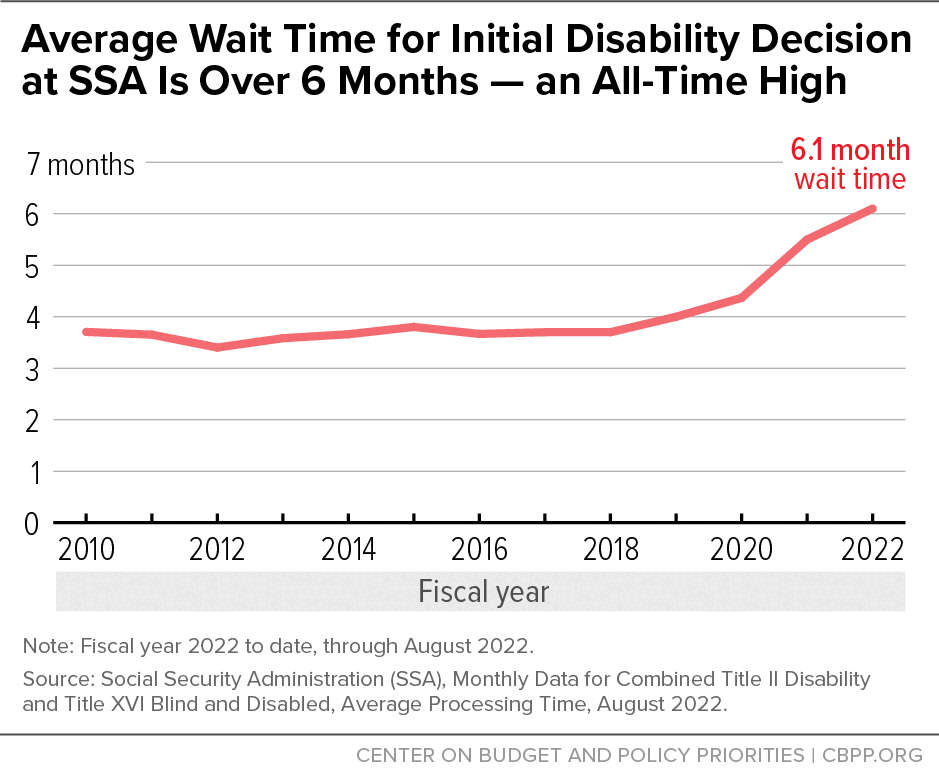BEYOND THE NUMBERS
Social Security Administration Needs Boost in Continuing Resolution to Avoid Customer Service Crisis
Customer service delays at the Social Security Administration (SSA) are causing serious problems for applicants and beneficiaries, who are enduring record-long waits for disability decisions, long hold times on the agency’s 800 number, and other problems stemming from a decade of austere administrative funding and compounded by the COVID-19 pandemic. These delays cause significant stress and financial hardship, and backlogs will continue to grow unless policymakers act. Congress should use the upcoming temporary government funding measure to begin fixing this situation, by including “anomaly” language proposed by the Biden Administration to increase that legislation’s funding for SSA.
Without such relief, people will wait even longer to get their benefits and to receive assistance from SSA staff, as the agency loses thousands more staff and can’t make do with remaining staff given the needed cuts to overtime.
Because no appropriations bills have been enacted for fiscal year 2023, which begins October 1, Congress will have to pass a stopgap funding measure known as a continuing resolution (CR) to prevent a partial shutdown of agencies, including SSA, that are funded through annual appropriations. CRs generally continue funding at the spending rate and conditions set in the prior year’s appropriations bill. Amounts spent under a CR are charged to the regular full-year appropriation once it is enacted.
But continuing resolutions always include some “anomaly” provisions, raising the funding for a small number of programs with urgent needs or changed circumstances. For example, the initial CR for 2022 included more than a dozen sections increasing the temporary funding for certain activities above the prior year’s rate.
In keeping with this long-standing practice, the Administration has proposed various anomaly provisions for the forthcoming CR. Among them is language that would raise SSA’s annualized operating budget by $800 million, or 6 percent, while the CR is in effect. This is less than the full increase of $1.3 billion for SSA’s operating budget the President requested for 2023, but it would at least prevent the situation from deteriorating while Congress considers full-year appropriations.
SSA presents a compelling case for anomaly treatment in the CR because simply continuing funding at the prior year’s level would not be enough to keep the agency’s customer service from continuing to worsen, for at least two reasons.
First, SSA’s operating budget has been starved for over a decade, forcing the agency to shrink its staff — and compromise its service. Since 2010 SSA’s workloads have expanded dramatically, with the number of Social Security beneficiaries increasing by 11 million or 21 percent. At the same time, SSA’s operating budget shrank 17 percent counting inflation, and its staff by 13 percent. SSA staffing is now at its lowest level in 25 years, and the agency continues to lose employees. SSA lost 4,000 employees during the pandemic, a 7 percent decline, because budget shortfalls forced SSA to freeze hiring.
And second, if SSA is forced to make do on 2022 funding levels — even if only until the proposed CR expires in December — the agency will have to cut back further. That’s because in 2023 the agency must absorb more than half a billion dollars in fixed-cost increases, such as employee pay raises, rising benefit costs, and increases in rent and postage — which are rising higher than usual because of inflation. As a result, the agency would implement another hiring freeze if they don’t get an increase in funding under the temporary CR, meaning that their staffing will fall further behind demand, at least through the end of the year when final appropriations are completed (and only then if the final bill provides adequate funding). The agency expects to lose nearly 6,000 SSA and disability determination service (DDS) employees in 2023. It would also have to significantly cut overtime compared to 2022 levels, meaning existing employees couldn’t make up the difference.
Fewer employees combined with higher demand would make it even harder for people to access their Social Security benefits and other services. With thousands fewer SSA employees to answer the phones, take appointments, answer questions, solve problems, and process applications, Social Security’s customer service problems will get even worse.
In August 2022 the average wait for an initial disability decision at SSA hit an all-time high of 198 days (6.6 months), more than two months longer than before the pandemic. (The average so far this year is 6.1 months; see chart.) Without the requested anomaly funding, this unacceptable waiting time will continue to grow. The SSA-funded state disability determination services that make disability decisions have been experiencing record turnover, with annual attrition of over 25 percent. Under a hiring freeze, SSA couldn’t replace these departing employees, fueling even longer delays.
Already, over 1 million disability claims are pending at state DDS agencies (including claims at both the initial and reconsideration level). More people waiting for disability decisions, and longer waits for the decisions, takes a toll on individuals, families, and communities.
Problems at SSA’s 800 number are also growing. In 2020 nearly half of calls to SSA went unanswered because callers hung up when the wait was too long, or they got busy signals. During 2022, average hold times on the 800 number grew to over 30 minutes — another unfortunate agency record and more than ten minutes longer than before the pandemic. Without an anomaly, applicants and beneficiaries will face even longer waits to get help from SSA staff. SSA’s teleservice centers experienced the highest turnover rates in the agency (not counting the DDSs), so a hiring freeze would hit the 800 number service hardest.
It’s vital that policymakers restore SSA’s funding and staffing so that applicants and beneficiaries can get their benefits promptly and access assistance when they need it. Congress can start by ensuring the agency has enough funding to see it through mid-December without further compromising service. Then policymakers should turn to providing stronger and steadier full-year funding. President Biden’s request for 2023 would be an important down payment on restoring Social Security’s promise to the American people.

